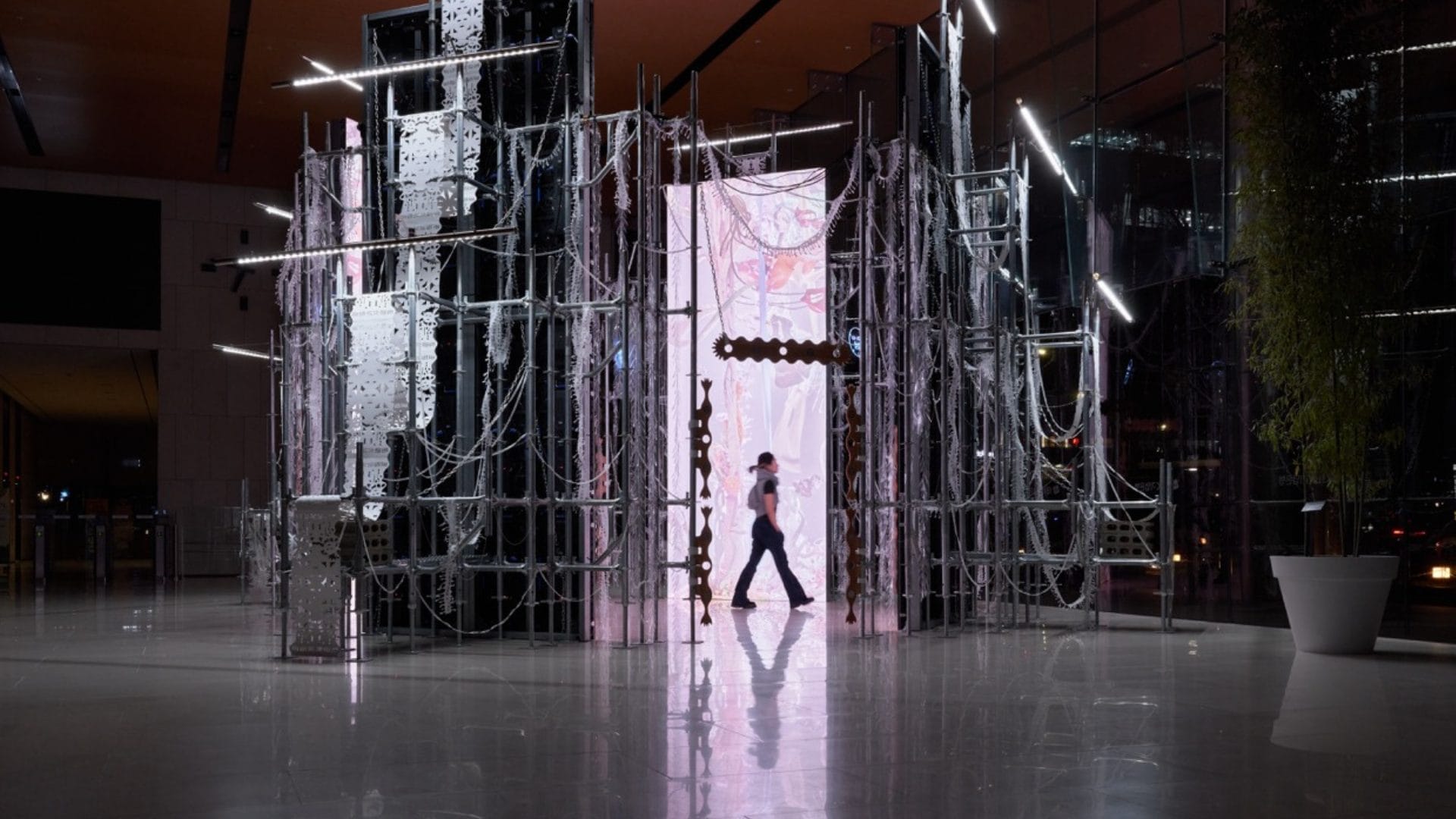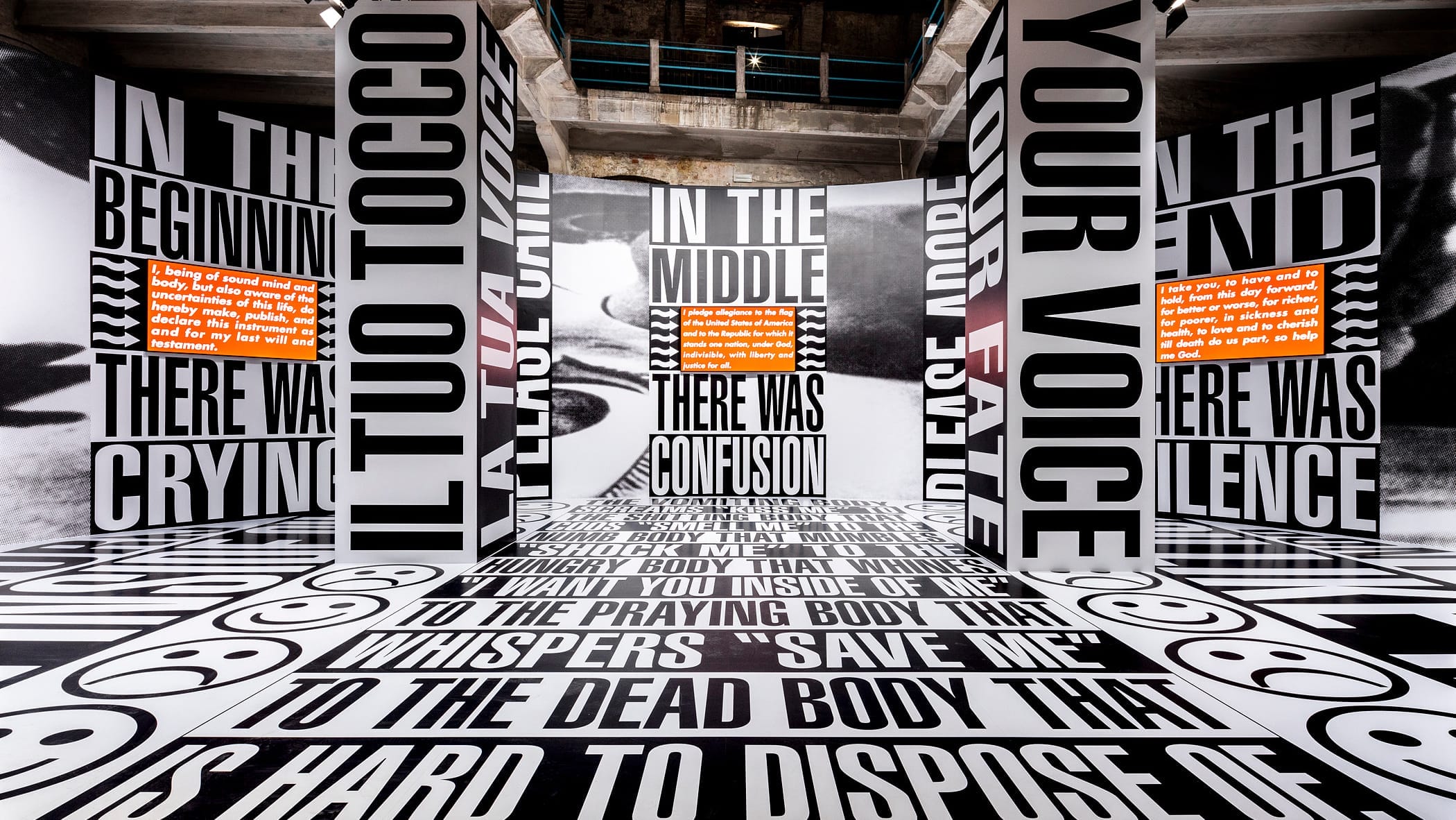
Words and Power: Barbara Kruger’s Visual Revolution
Let’s talk about Barbara Kruger, the artist who turned art into a boxing ring where words are her punches. Imagine walking into an art gallery and BAM! Her works hit you like a straight punch to the face. Words in black and white on flashy backgrounds stare at you like the eyes of an overly insistent ex. “I shop therefore I am” – really, Barbara? That time I saw this phrase, I thought: “Now I feel the need to buy a coffee just to prove my existence.”
Kruger doesn’t work quietly, rather, she asks questions with a megaphone. It’s as if she takes society’s most provocative thoughts and shouts them through a visual collage. Talking about power, identity, and sexism? Barbara knows how to shake the conversation table. And the beauty of it? She doesn’t stop at sweet words. She’s as direct as a strong punch straight to the face.
But what makes Kruger’s art so provocative and relevant? At the heart of her work, we find a deep social and cultural critique, articulated through a unique visual and verbal collage. Her works, often perceived as a form of artistic activism, explore themes such as power, identity, sexism, consumerism, and control. This choice is not random but intentional: Kruger uses art as a tool to stimulate critical reflection in the audience, challenging established perceptions and raising uncomfortable questions. How can we interpret her incessant questioning of power mechanisms? What is the effect of her direct and uncompromising approach on the public’s understanding of social and political dynamics?
Language is a key element in Kruger’s art. It’s not just a means of communication, but a real tool of power. Her incisive and direct phrases, often presented in headline format, capture attention and stimulate critical reflections. Kruger shows how language can be used not only to express but also to influence and manipulate thought and perceptions. This leads us to reflect: how do Kruger’s words resonate in our social and cultural context? How do they influence our way of seeing the world?
Another fundamental aspect of Kruger’s art is her direct dialogue with the viewer. Her works, often large in size and installed in public spaces, are not just to be observed, but to be experienced. They create an immersive experience that forces the audience to confront the raised themes, challenging beliefs and prejudices. What impact does this type of interaction have on our understanding of art and its function in society?
Finally, it’s impossible to talk about Kruger’s art without mentioning her contribution to the feminist discourse. Through images and words, Kruger addresses issues such as gender discrimination, the objectification of women, and the fight for equality. Her work is part of a broader context of feminist activism, enriching the debate on the representation of women in art and culture. How can we interpret her contribution in this field? How has her work influenced the perception of the role of women in art and society?

Emotionality and language as an instrument of power
The exploration of Barbara Kruger’s art takes us into a territory where language and emotion merge to create a critical dialogue that transcends mere visual expression. In this context, language becomes a tool charged with emotional force, used not only to convey messages but also to evoke, disturb, and question. We thus encounter an art form that, through words, raises questions about reality and our perceptions, prompting us to reflect on broader issues related to language and imagination.
Kruger’s phrases, such as “I shop therefore I am” or “Your body is a battleground,” are stark examples of how words can shake our deepest beliefs and influence our behaviors. These statements, in stark contrast with the accompanying images, generate a tension that immediately evokes an emotional reaction. This leads us to ask: how does Kruger’s language affect our emotions? In what ways do her words shape our perception of reality?
Through her works, Kruger explores power dynamics in society, using language as a critical tool. Her direct and sharp expressions question the nature of power, its distribution, and manifestation in everyday life. Reflecting on this aspect, we come to consider how language can be employed to exercise power, to oppress or liberate, to conceal or reveal the truth. This prompts us to reflect on the ambiguous nature of language: is it a means to communicate truth or a tool of manipulation?
In Kruger’s art, the representation of reality through language takes on a central role. Her works highlight how words can simultaneously reveal and hide the truth, be instruments of freedom or chains of oppression. This leads us to reflect on the ambiguous nature of language and its role in shaping our perception of the world. How can we trust words as vehicles of truth? What is the true power of language in representing reality?
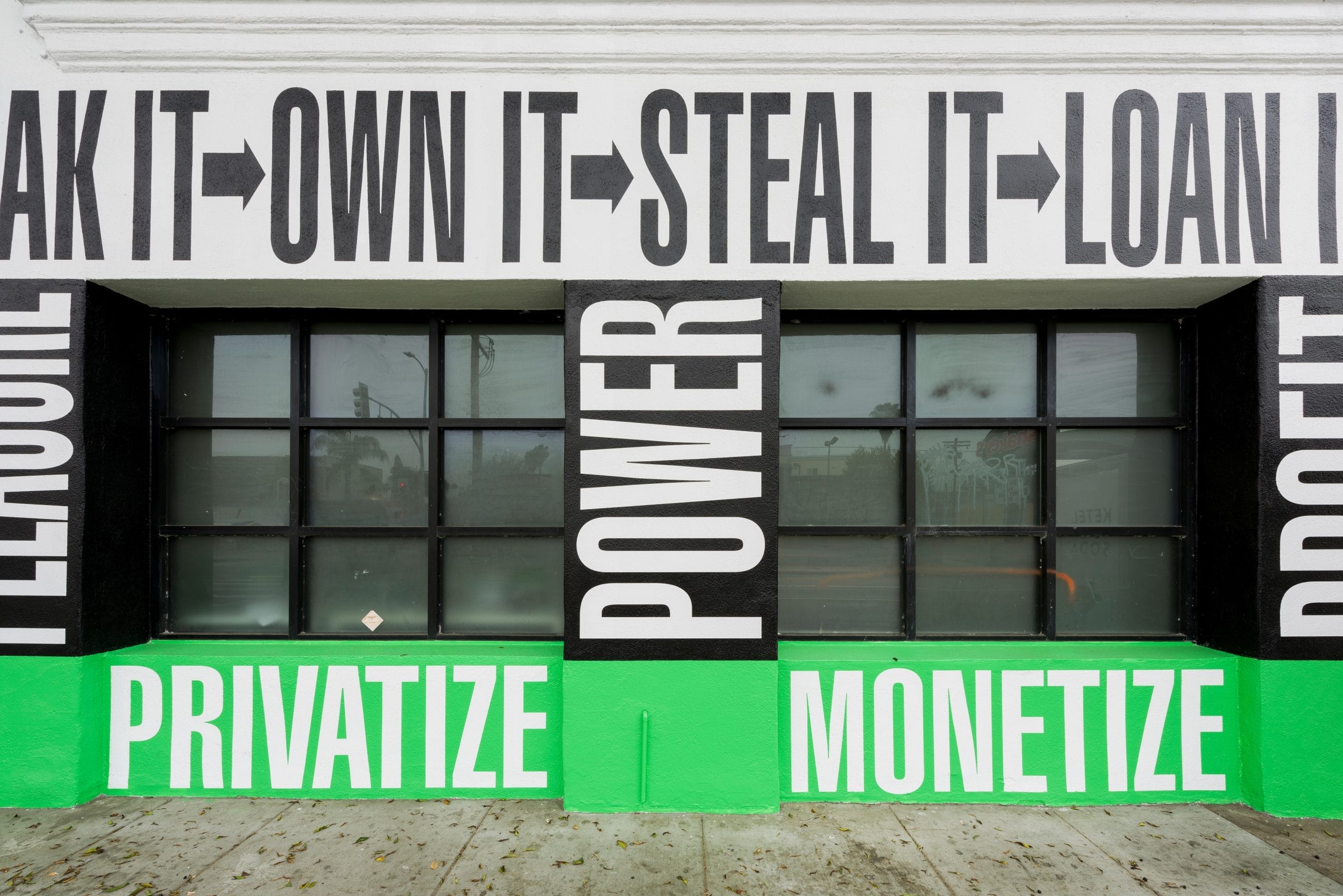
The Influence of Post-Structuralism and Feminism on Kruger’s Art
Barbara Kruger’s art, focusing particularly on the influence of post-structuralism and feminism. These streams of thought have not only informed Kruger’s artistic approach but also provided a critical framework through which her work can be understood and evaluated. We examine how these influences have enriched and complicated her artistic practice, leading to a broader dialogue on gender, power, and representation.
Post-structuralism, with its distrust of dominant structures and narratives, has offered Kruger a tool to deconstruct social and cultural conventions. But how exactly does this philosophical current reflect in Kruger’s art? We can see her use of text and image as a way to dismantle dominant narratives, exposing discrepancies and contradictions within discourses of power. This leads us to ask: how do Kruger’s techniques resonate with the principles of post-structuralism? How do her works contribute to a broader understanding of power structures and their representation?
Feminism has provided Kruger with a context to explore and challenge gender dynamics in society and art. Through her work, Kruger interrogates the ways women are represented and perceived, often challenging sexist and reductive representations. Her use of provocative words and powerful images is a call to action against gender injustices. However, how can we interpret the impact of feminism on her works? How does Kruger use her artistic medium to advance feminist discourse, and what are the implications of this approach?
In Kruger’s art, post-structuralism and feminism intersect, creating a unique synthesis that examines and critiques power structures and gender representations. This intertwining of influences leads us to consider how art can serve as a critical tool to examine and challenge social and cultural norms. How does Kruger’s approach help us better understand the complex interactions between language, power, and identity?

Picture/Readings: An In-Depth Analysis
There is a lesser-known but equally significant series by Barbara Kruger: “Picture/Readings”. This series represents a pivotal moment in Kruger’s artistic evolution, offering a unique perspective on her narrative methodologies and her ability to combine images and text to create powerful messages. We examine how “Picture/Readings” stands out within Kruger’s body of work and what are the broader implications of this series for understanding her work.
Unlike her more well-known works, characterized by short, impactful phrases, “Picture/Readings” presents longer, more elaborate stories. This series combines images, mainly of the exteriors of houses in Berkeley, Los Angeles, and Deerfield Beach, Florida, with texts that have cinematic, novelistic, and melodramatic ambitions. How can we interpret this narrative approach? How does it differ from Kruger’s more typical practice, and what new dimensions does it open in her work?
In “Picture/Readings”, Kruger constructs a visual and linguistic architecture, where blocks of text and image overlap and interact. This aspect prompts us to reflect on the relationship between text and image in her work. How do they influence each other? How does Kruger use this interaction to construct complex narratives and challenge visual conventions?
The stories in “Picture/Readings” often focus on scenes of everyday life, introducing a dimension of intimacy and realism. This leads us to consider the role of everyday life in Kruger’s art. How does she use these representations to explore broader themes such as identity, relationships, and power? What is the impact of this approach on the audience and their ability to relate to the work?
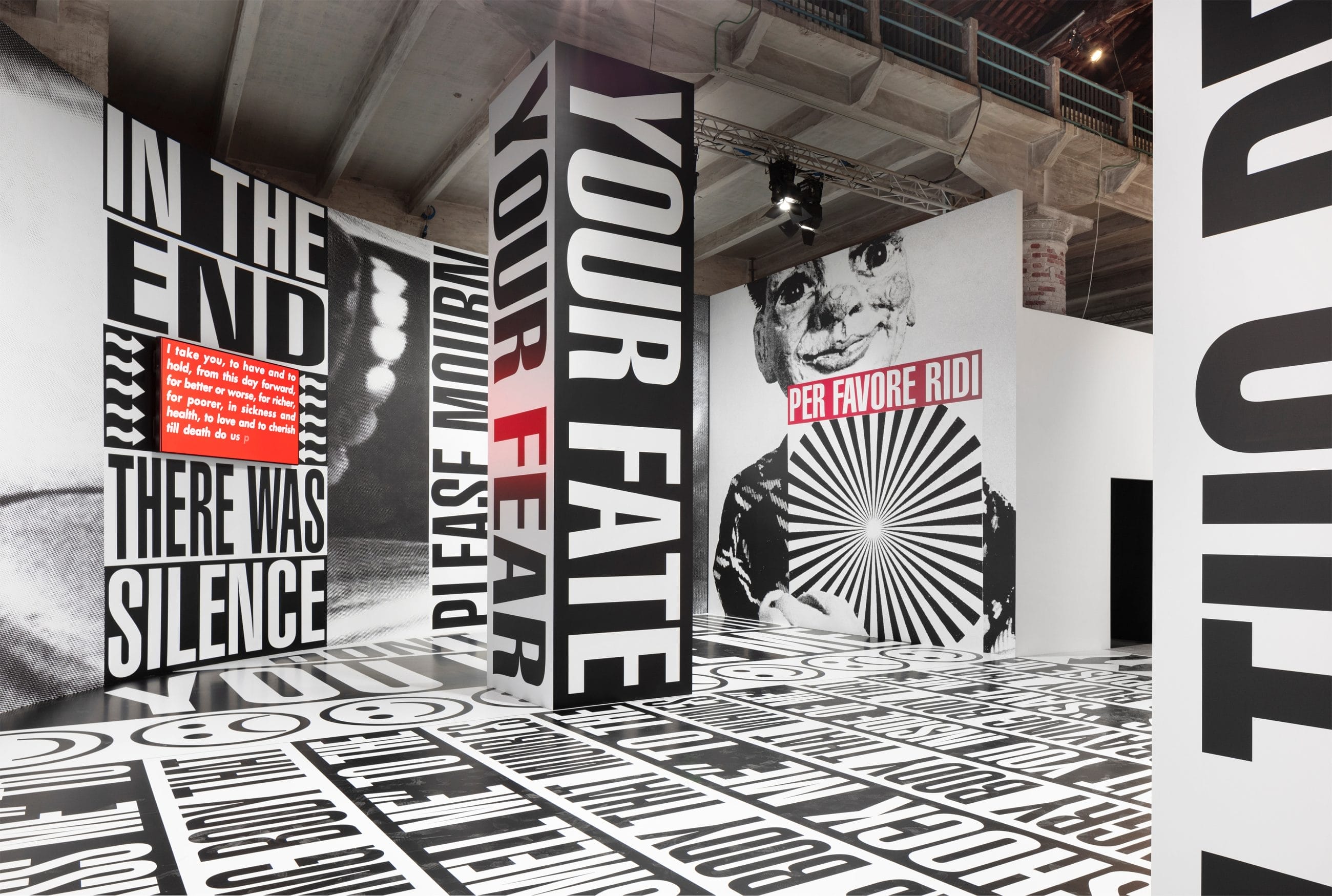
Gender Dynamics and Theatricality in Kruger’s Art
In Kruger’s works, theatricality serves as a powerful means of expression. Her images and texts often evoke a sense of performance, where meaning is found not only in the content but also in its presentation. This use of theatricality raises several questions: how does theatricality in Kruger’s works amplify the message? How does it interact with the content to create a more engaging experience for the viewer?
Kruger’s art is deeply rooted in the critique of gender dynamics. Through her works, Kruger questions traditional representations of masculinity and femininity, often overturning or complicating these narratives. This critique invites us to reflect: how do Kruger’s works challenge our perceptions of gender roles? What are the implications of these challenges in the broader social and cultural context?
In Kruger’s work, theatricality intertwines with feminist themes, creating a visual critique that is both captivating and thought-provoking. Her artistic approach can be seen as a way to emphasize and make feminist issues visible. This raises an important question: how does Kruger’s use of theatricality serve to strengthen and disseminate the feminist message? How does it contribute to a broader dialogue on the role of art in the fight for gender equality?
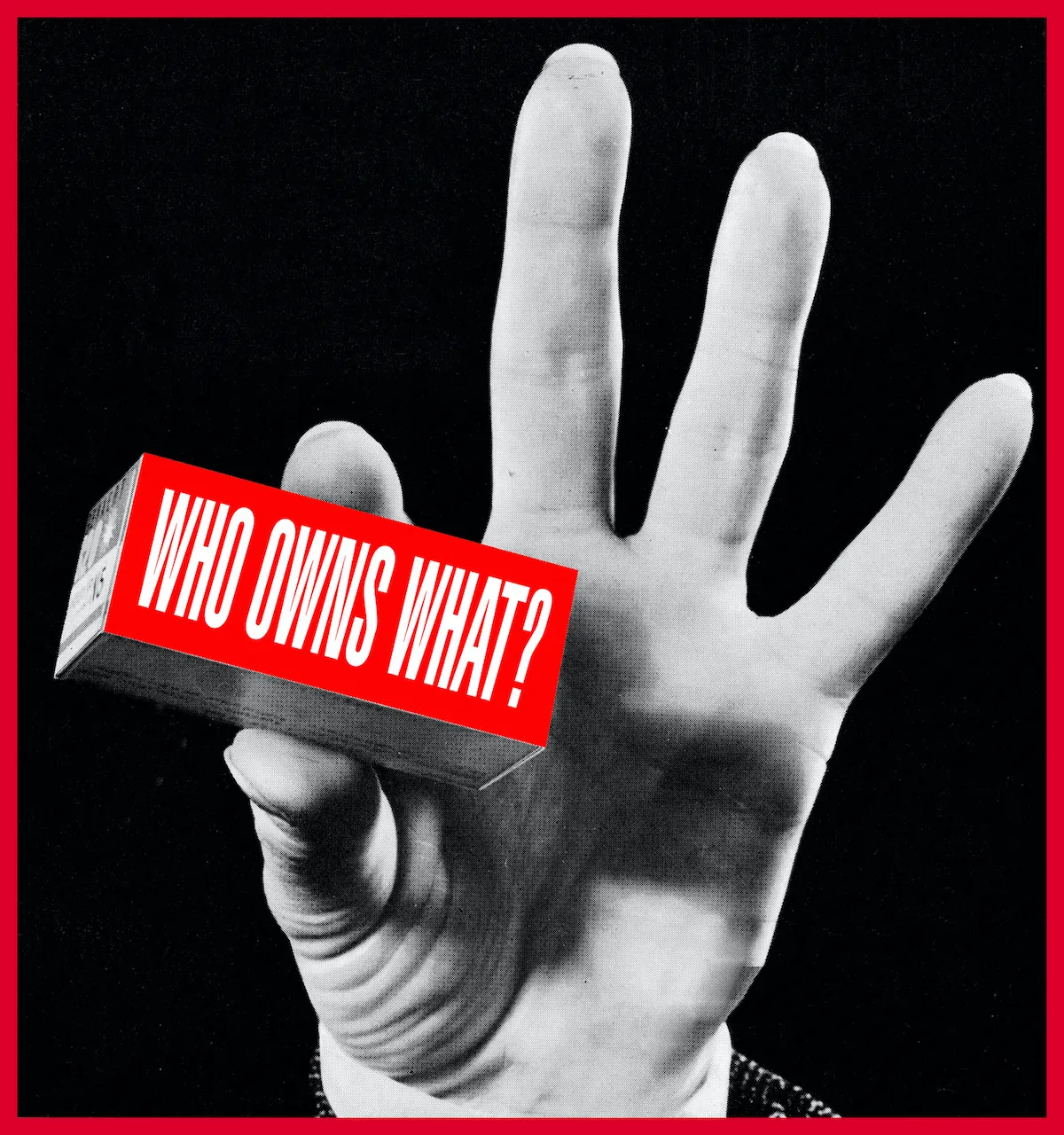
Criticism and Complicity in Contemporary Art
In the sixth chapter, we analyze the role of Barbara Kruger’s art in the context of criticism and complicity in contemporary art. Kruger, through her work, addresses and challenges the binaries of criticism and complicity, posing essential questions about how art can simultaneously be an instrument of social critique and an integral part of the system it critiques. This chapter explores the dynamic tension between these two poles in Kruger’s work and how it reflects and influences the broader debate on contemporary art.
Barbara Kruger is known for her critical approach to power structures and social conventions. Her works stand out for their ability to raise important issues regarding consumerism, sexism, and authority. But specifically, how does Kruger’s art function as a critique? What strategies does she use to interrogate and challenge the audience and the artistic system?
Despite its critical nature, Kruger’s art does not escape the dynamics of the art world, which includes galleries, museums, and the art market. This raises a crucial question: how can Kruger’s art, or any art aiming to be critical, avoid complicity with the structures it seeks to contest? How does Kruger manage this tension, and what are the implications for her work and for contemporary art in general?
Examining Kruger’s work, we find ourselves facing a complex interaction between criticism and complicity. Her works, while being strongly critical, are also a product and part of the art world they interrogate. How can we interpret this intersection? How does Kruger’s work force us to reflect on the challenges and possibilities of contemporary art as a means of social commentary?
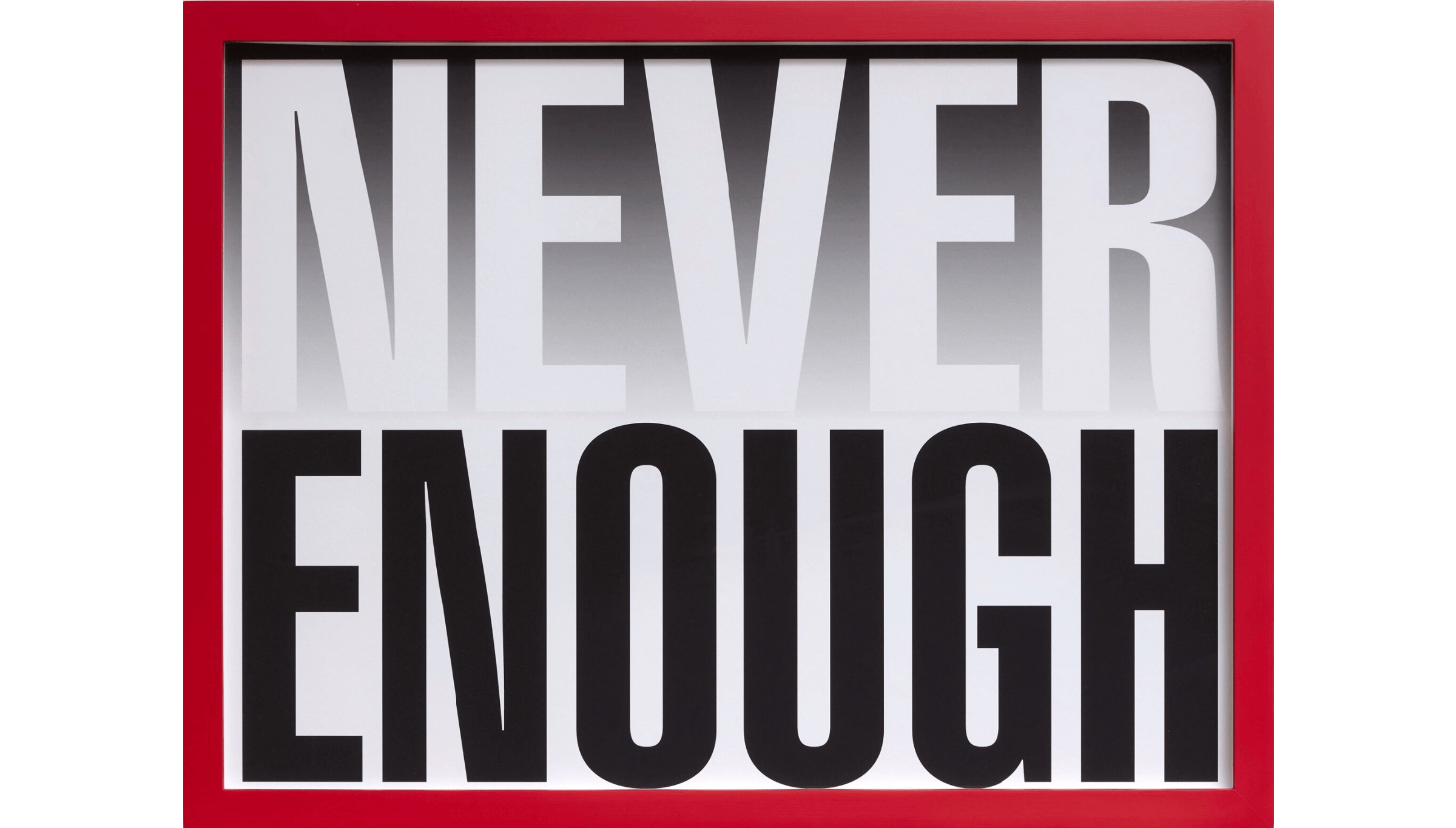
The Future of Kruger’s Art and its Cultural Impact
Having explored the various dimensions of her work, from social and gender criticism to the complexity of language and theatricality, we ponder how Kruger’s legacy will continue to influence the world of art and culture at large.
Kruger’s art has already made an indelible mark on the contemporary artistic landscape. Her works, challenging conventions and stimulating critical dialogue on important issues, have blazed new trails for art as a form of social and political activism. How will Kruger’s influence continue in the art world? What new directions might her work take in response to social and cultural changes?
Through Kruger’s example, we can reflect on the broader role of art in contemporary society. Her works challenge us to consider how art can be a means to explore and address social, cultural, and political issues. How can art continue to act as a catalyst for social change? How can artists draw inspiration from Kruger’s work to create pieces that are both provocative and meaningful?
Kruger’s cultural impact extends beyond the art world; it affects how we think about media, advertising, and cultural representations in general. Her works invite us to be critical of the messages we receive daily and to question power structures within society. What will be the ongoing role of Kruger’s works in shaping cultural discourse? How can her art inspire future generations to examine and challenge the world around them?

TheImpact of Kruger’s Art on Society
Kruger’s work acts as a mirror reflecting the complexities, contradictions, and conflicts of contemporary society. Her pieces challenge not just artistic conventions but also social and cultural norms. How does Kruger’s art compel us to reflect on ourselves and the world we live in? What lessons can we draw from her critical and provocative approach?
Kruger’s message has proven to be not only powerful but also persistently relevant. In an era of rapid changes and global challenges, her works continue to stimulate critical thinking and discussion. How can the themes addressed by Kruger – such as power, identity, consumerism, and sexism – remain relevant in an ever-evolving social and cultural context?
Kruger’s impact is not confined to her own era; her work is destined to influence future generations of artists, critics, and activists. How can her art inspire new forms of expression and activism? Which aspects of her work can be adopted or adapted by those seeking to use art as a means for social change?
Barbara Kruger’s art reveals itself as an inexhaustible source of inspiration and reflection. Through her ability to combine text and image to convey powerful messages, Kruger has not only left an indelible mark in the world of art but has also provided a model for how art can be used to question and influence society. Looking to the future, Kruger’s legacy will continue to be a fundamental point of reference for those seeking to understand and transform the world through art.
Barbara Kruger (*1945, Newark, NJ) lives and works in Los Angeles and New York. Solo shows include The Art Institute of Chicago (2021), AMOREPACIFIC Museum of Art, Seoul (2019), National Gallery of Art, Washington, DC (2016), High Line Art, New York (2016), Modern Art Oxford (2014), Kunsthaus Bregenz (2013), Pinakothek der Moderne, Munich (2011), Schirn Kunsthalle, Frankfurt (2010), Gallery of Modern Art, Glasgow (2005), Whitney Museum of American Art, New York (2000), Museum of Contemporary Art, Los Angeles (1999), Serpentine Gallery, London (1994), Musée d’art contemporain, Montreal (1985) and Kunsthalle Basel (1984). Group shows include those at Hamburger Bahnhof (2018), V-A-C Foundation, Palazzo delle Zattere, Venice (2017), Hammer Museum, Los Angeles (2014), Biennale of Sydney (2014), Museum Ludwig, Cologne (2013), Stedelijk Museum, Amsterdam (2010), Museum of Modern Art, New York (2007, 2009, 2010), Palazzo Grassi, Venice (2006), Museum of Contemporary Art, Chicago, IL (2004), Tate Liverpool (2002), Centre Pompidou, Paris (1988) and Solomon R. Guggenheim Museum, New York (1987). The current major solo exhibition will travel to the Los Angeles County Museum of Art and will also have a station at the Museum of Modern Art, New York.
Night Time Story
NIGHTTIMESTORY is a decentralized and online project that aims to be a platform for show a wide range of contemporary art forms, including visual art, videoart, conceptual art theory, NFTs, and critique.
You may also like
Generative Futures: Interactivity in a Post-Web3 World
Through a synergistic fusion of blockchain technology and advanced creative coding, generative art i
Yaloo, Pickled Chamber at Industrial Bank of Korea Headquarters, Seoul
“Pickled Chamber” by Yaloo, curated by Wooim Kim and Kihyun Na, at Industrial Bank of Ko
Fakewhale’s ART MARKET Debuts on Foundation
Initially debuted on objkt.com as part of one of Fakewhale Gallery’s signature formats, on July 17



